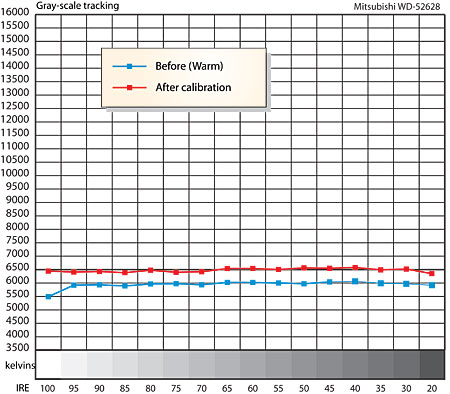Mitsubishi WD-52628 DLP RPTV Tests and Calibration
The Mitsubishi performed satisfactorily on most of our deinterlacing and scaling torture discs. It passed the tests on the Faroudja test DVD, including unflagged 3/2 pulldown. On the HQV Benchmark DVD, however, it rated no better than fair on the two jaggies tests, showed artifacts in the brick detailing behind the waving flag, and failed the racetrack bleacher test. However, LEU noted in the review that deinterlacing and scaling artifacts were hard to spot on normal video program material (including that difficult scene at the beginning of Star Trek: Insurrection).

At 480i, 480p, and 720p, the Mitsubishi's luminance (black and white) and chroma (color) response held up well to the highest frequency multiburst from my Accupel HDG-3000 test pattern generator at each of those resolutions, though the 720p output was clearly down in level at 37.1MHz. At 1080i, however, there was no luminance or chroma response at 37.1MHz, though the set's output was still strong at 18.5MHz. This suggests that this 1080p set might actually look better with 720p sources, but in practice LEU did not report any noticeable shortcomings with fine detail resolution in the set's day-to-day performance with 1080i sources.
On the sharpness test pattern from my Accupel HD generator, the Mitshbishi exhibited ringing (white lines on both sides of the horizontal and vertical black lines in the pattern) that could not be eliminated even with the sharpness control at minimum. Surprisingly, however, I did not see any obvious fallout from this on normal program material. LEU, who lived with the set for several months, did not complain about it.
With a 480p or 480i input, either component or HDMI, the set's overscan ranged between 2.5% and 3.5%. At 720p and 1080i, component or HDMI, the overscan was slightly less, at a maximum of 3%.
The Mitsubishi's color primaries ranged from good to excellent. Green, in particular, was admirably well controlled. When I calibrated the set in Larry's home theater room, I was immediately impressed by the quality of the Mitsubishi's greens. They were far more natural and less cartoonish than I have seen on most digital displays.
The set's pre-calibration gray scale (in Low mode) was several hundred degrees south of the optimum D6500 (High was well beyond useful, hovering around 12,000K). After calibration the Low mode was noticeably better, not only in degrees Kelvin but in how closely each measured point adhered to the D6500 standard. The final deviations from D6500 were no greater than ±0.004 of the target x/y coordinates across the full brightness range.
At Mitsubishi's line show last spring, it was claimed that the DeepField Imager included some sort of automatic iris. LEU reports, however, that turning DeepField on and off did not appear to affect dark scenes in a way that would suggest such an iris. If the set does have an auto or dynamic iris, it must be non-defeatable.
Nevertheless, the WD-52628 turned in a solid peak contrast result of 2899:1 (63.77 foot-Lamberts peak white, 0.022fL video black).





























































